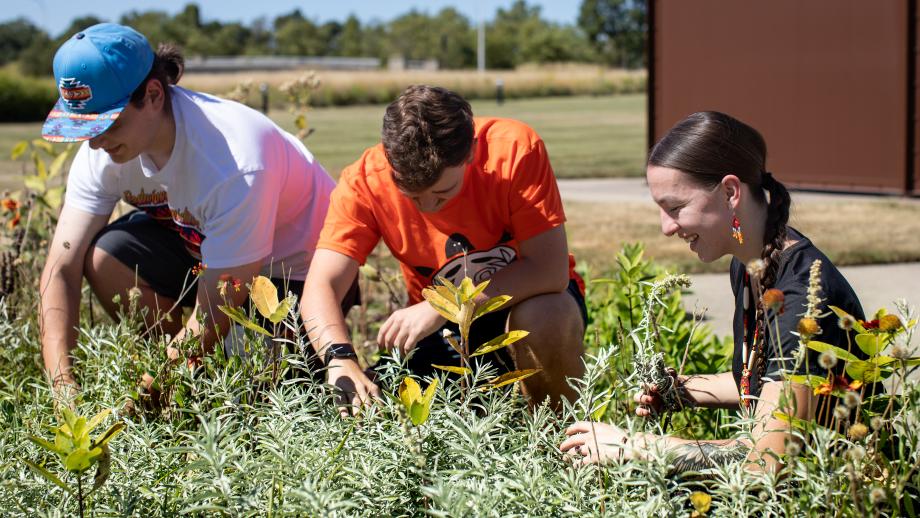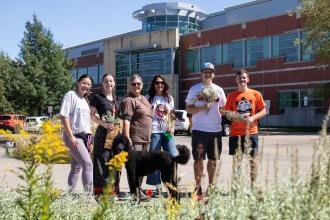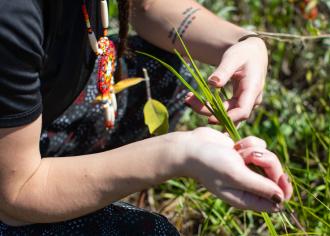Medicine garden harvest helps kick off academic year for Native American Student Organization
KALAMAZOO, Mich.—Under the hot August sun, Shabanaa Bush carefully ties bundles of sage freshly harvested from a bed in front of Western Michigan University's Floyd Hall.
Inside the building, home to the College of Engineering and Applied Sciences, Bush connects with world-class faculty in pursuit of a degree in aerospace engineering. Outside, she's able to connect with her Native American heritage through a community medicine garden.
"Having the medicine garden right outside of where I study and learn is a visual reminder of who I am and the recognition my culture has at WMU. Engineering is hard, but knowing my people’s sacred medicines are close and always accessible to use reassures me that my community supports me," says Bush, president of the Native American Student Organization (NASO).
Alongside fellow NASO members, Bush spent an afternoon trimming sage and sweet grass to be used in smudge ceremonies—an Indigenous practice where sacred herbs are burned to bless and cleanse spaces—before events.
"By having this garden, NASO at WMU aims to bring accessibility and recognition to our culture," Bush says. "I am so thankful to be blessed with such an amazing University that works with its Indigenous students and staff to make them feel at home and celebrated to be who they are."
Skyler Wolverton, B.S.'24, a NASO student leader and graduate student, adds the garden gives Native students a sense of place on campus. "I have studied geography in my undergrad and continue to do so in graduate school. Having a sense of place is vital to any community."
Rooted in tradition
The garden, which was developed in consultation with Tribal nations in the region in late 2019 and early 2020, includes sage, sweetgrass and tobacco—three of the four sacred medicines of the Ojibwe medicine wheel. Jodie Palmer, former Western staff member and Council member for the Gun Lake Tribe, and Laura Moss, gardener in Landscape Services, brought the idea to fruition.
"It's been so rewarding to see the community medicine garden grow," says Dr. Dee Sherwood, director of Western's Native American Affairs Council and NASO advisor. "I'm so grateful for their vision and persistence, because the garden is thriving and NASO students, relatives, alums and community members now have a place on campus that supports plants, medicines and cultural practices."
The garden is open to members of the campus community and tribal community as a whole to gather sacred medicines as needed.
"Through this medicine garden, WMU is working to reconnect our culture to the land of our grandparents and relatives," says Bush. "Having this medicine garden for the community has created a more accessible and ethical way for our relatives to collect the medicines they need without having to wait for a powwow or order from a third-party company that may not be Indigenous. I hope that this medicine garden can be cared for and used by the next generation of Broncos."
Wolverton adds the garden makes it possible for him to not only harvest medicines for his own practices but to share them with others.
"I plan on making sage bundles to thank the tribal entity I am working with in my master's program and another college who has aided and worked with me all summer, as well," he says. "That's what our medicine is there for. To our people, you are not rich because of the amount you have; you are rich because of the amount you give. This medicine bed will allow us to give to peers, to the land and to the future of NASO—always passing on our ways to the next generation."
For students like Wolverton, the medicine garden is a physical manifestation of the sense of belonging he's cultivated with NASO. Beginning his undergraduate studies at Western at the height of the COVID-19 pandemic, the relationships he's formed in the organization have helped him to thrive.
"When I joined up with NASO, I was presented with so many opportunities to be involved and work together with other like-minded people. I learned so much in the organization and I gained so many opportunities to develop spiritually and professionally," he says. "I landed an internship and eventually enrolled in graduate school, which I accredit as a direct result of me joining NASO. If I didn't have the community I have around me, I don't know where I would be in life right now."
"I am so proud of NASO students," adds Sherwood. "They are so bright, talented and caring, and they are collaborating across the University with other student groups, departments and centers. Seeing the impact of their individual and collective work and growing visibility and presence on campus makes my heart happy."
NASO meets on the third Thursday of every month. More information about getting involved and upcoming events is available online.
For more WMU news, arts and events, visit WMU News online.




